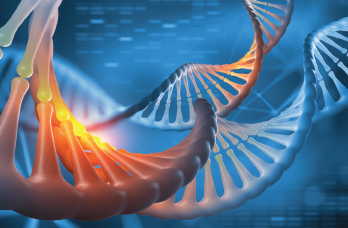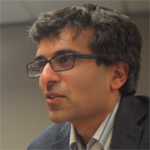
Yurchanka Siarhei / shutterstock.com
ATLANTA—The increasing ease and the lowering cost of genome and exome sequencing make discovery and diagnosis of rare diseases more feasible than ever, but hurdles still need to be cleared before the world of medicine can fully harness the power of this information boom, experts said in a session at the 2019 ACR/ARP Annual Meeting.
Chip Chambers, MD, former chief of endocrine surgery at Vanderbilt University, Nashville, Tenn., said his two children were diagnosed with deficiency of adenosine deaminase 2 (DADA2) in 2014. The first two articles1,2 describing the disease were published that year—and since then he has worked to improve awareness and promote research for better treatment of the disease, founding the DADA2 Foundation. He also continues to hold his clinical faculty appointment at Vanderbilt, and he operates and teaches residents at the Veterans Affairs Medical Center.
Need for Faster Progress
Half of people with rare diseases are children, and 30% of them won’t reach their 5th birthday, Dr. Chambers said. The need for faster progress is obvious, he stressed.
“How can progress be made in a time frame that’s a lot shorter than we’re accustomed to?” he said. “We shouldn’t be okay with the pace that we’re on related to rare diseases. … It’s just unacceptable to me as a physician that 95% of these rare diseases don’t have an FDA-approved treatment.”

Dr. Chambers
Rather than the traditional linear approach that research and development often takes, in which one group discovers a disease, publishes on it and then has conversations about future work on it before life “gets in the way,” Dr. Chambers called for a nonlinear, web-based approach, incorporating patient registrations, fundraising, scientific collaborations and global connections.
Crucial, he said, is empowering patients and listening to their concerns with genuine curiosity.
“If we empower patients earlier on to take the next step, they are naturally curious,” Dr. Chambers said. “If we keep in touch with them and we coach them to ask the right questions, and we get them involved in the research early after a rare disease is discovered, that will help guide their natural curiosity.”
He added, “This new approach is going to make you uncomfortable—can challenge the norms of our profession—but what might it do for the greater science and medical community? More important, what might it do for the patients?”
Dr. Chambers urged clinicians to ask these questions of themselves: “Who is your one in 30 million patient? What is the next question you need to ask? How can your patients fuel this work with you?”
Interpretation of Data

Dr. Lee
Brendan Lee, MD, PhD, chair of molecular and human genetics at Baylor College of Medicine, Houston, said it’s true that the cost of genome and exome sequencing has plummeted, but that is just one part of the problem.
“The cost of sequencing is dropping enormously, but it is ultimately the interpretation of that sequence which is the challenge,” he said.
The results of whole exome sequencing are often not straightforward, pointing to a single diagnosis, Dr. Lee said. A study by a colleague at his center on whole exome sequencing (WES) of adults found that WES yielded a diagnosis rate of 17.5%, with a “dual” diagnosis involving “blended phenotypes” 7.1% of the time.3
Interpretation of WES data changes over time as new discoveries are made.
At Dr. Lee’s center, the diagnostic yield of WES at one time point was 25% in one cohort of 250, and at a later time point it was 36%. In a larger cohort of 2,000, the yield rose from 25% to 30% when re-analyzed later, he said.4,5
“This is why, in fact, our lab tries in a structural fashion to integrate re-analysis in our pipeline so that when one orders a test, there is … an interval subsequently when there will be a re-analysis,” Dr. Lee said. “And this is not an easy task given the nature of genomic interpretation.”
Exome sequencing of infants in intensive care produced a diagnosis 36.7% of the time, and in 52% of those cases the diagnosis affected medical care, either by redirection of care, referral of a subspecialist or in diet or medication.6
The bottom line question, Dr. Lee said, is how do we functionalize the genome?
He works with the Undiagnosed Diseases Network, in which patients apply and, if accepted, are seen at one of 12 regional U.S. sites. About 40% of patients are accepted for evaluation, and the diagnostic yield is 35%—even though many of the patients had exome sequencing done previously.
Dr. Lee said the Undiagnosed Diseases Network is not just out to make new diagnoses. It’s “also a laboratory in thinking about how this can be implemented more broadly.”
Challenges of Individualized Genomic Medicine
The promise is enormous, he said, but real challenges stand in the way of perfecting individualized genomic medicine. One is the knowledge itself, he said. “The knowledge base is evolving, and therefore this changes our interpretation.”
As individualization increases, the evidence base for it is bound to shrink, Dr. Lee said. “Sometimes there’s an inverse correlation with individualization and personalized medicine and what we view as evidence.”
“There are payer issues. And transformation of data into information requires the education of physicians and direct counseling of patients. And then there’s, of course, the regulatory oversight aspect.”
Thomas R. Collins is a freelance writer living in South Florida.
References
- Zhou Q, Yang D, Ombrello AK, et al. Early-onset stroke and vasculopathy associated with mutations in ADA2. N Engl J Med. 2014 Mar 6;370(10):911–920.
- Navon Elkan P, Pierce SB, Segel R, et al. Mutant adenosine deaminase 2 in a polyarteritis nodosa vasculopathy. N Engl J Med. 2014 Mar 6;370(10):921–931.
- Posey JE, Rosenfeld JA, James RA, et al. Molecular diagnostic experience of whole-exome sequencing in adult patients. Genet Med. 2016 Jul;18(7):678–685.
- Yang Y, Muzny DM, Reid JG, et al. Clinical whole-exome sequencing for the diagnosis of Mendelian disorders. N Engl J Med. 2013 Oct 17;369(16):1502–1511.
- Yang Y, Muzny DM, Xia F, et al. Molecular findings among patients referred for clinical whole-exome sequencing. JAMA. 2014 Nov 12;312(18):1870–1879.
- Meng L, Pammi M, Saronwala A, et al. Use of exome sequencing for infants in intensive care units: Ascertainment of severe single-gene disorders and effect on medical management. JAMA Pediatr. 2017 Dec 4;171(12):e173438.


